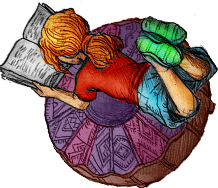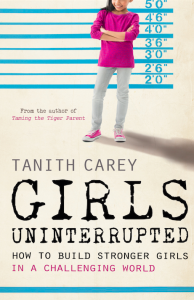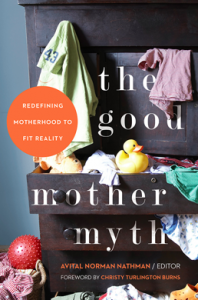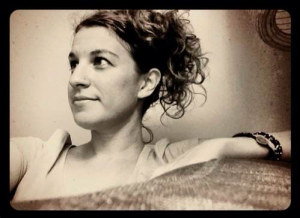Google is full of lists recommending girl-empowering books. Favorite female protagonists from the classics, like Pippi Longstocking, to more recent heroines, like Katniss Everdeen, abound on these lists, but I wanted to make my own after reading so many children’s and YA books to curate for recommendations in my book Her Next Chapter. Here are a few of my favorites, and why I liked them. These all come with original discussion guides in my book, so if you’ve got a mother-daughter book club and any of these pique your interest, you’ll be all set! Or, read these books with your daughters at home and be a book club of two!
My faves, and why…
1. The True Confessions of Charlotte Doyle by Avi (age 10+)
In this fast-paced Newbury award winner, Charlotte Doyle is a typical well-mannered girl of wealthy upbringing in the year 1832 who must return home to her family in America after attending school in England. The two-month voyage she takes by ship presents her with substantial challenges and dangers usually encountered only by men, forcing her to abandon many of her preconceived ideas about the “proper place” for girls and to completely reevaluate her role within her family and society. One might call the book a gender bender—somewhat along the lines of Kidnapped, Mutiny on the Bounty or Treasure Island, but centered upon the experience of the female protagonist. There are many exciting twists, with several mysteries woven throughout the plot. I had read this book years ago and forgotten a lot of it, but when I sat down to read it again, I polished it off in one long afternoon, unable to put it down!
Of great interest to me as I read the book was the concept of the traditional female identity being based upon the “ladylike” qualities of beauty and proper attire, meticulous attention to cleanliness and appearance at all times, and obedience to men. Throughout this book, that ideal is repeatedly held up and examined in ways that both fit the context of a book set in the year 1832 and remain relevant today. In a modern culture that still stereotypes girls and women as being all about their outsides, this book shows the reader what is inside a thirteen-year-old girl who can no longer afford to keep up appearances in either sense of the term. Charlotte becomes a character of great complexity who has much more going on inside her than her outward appearance would lead you to believe at the start of the book.
This is one of those riveting page-turners that girls will not be able to put down. The protagonist draws you into her life aboard ship and it’s hard not to feel every wave, every wind, and every moment of joy, fear, courage, disappointment, confusion, and enlightenment that Charlotte Doyle feels herself. Daughters need not have experienced their own swashbuckling adventures to be able to talk about the times in their own lives when they have been forced out of their comfort zones and triumphed!
2. Beauty Queens by Libba Bray (age 12+) Part Lord of the Flies, part America’s Next Top Model, and part Gilligan’s Island, Libba Bray’s fast-paced, tongue-in-cheek send-up of American girl culture, reality TV, and a beauty industry run amok is some of the smartest social commentary I’ve ever read in the YA Lit genre. Fifty contestants in the Miss Teen Dream Pageant are in a plane crash and find themselves surviving, Lost-style, on a desert island without make-up or cameras, and also without food, water, or shelter. Their surreal adventures as they cope with their own human foibles without hairspray or the Internet are actually an interesting counterpoint to the descent into savagery seen among the boys in Lord of the Flies. For these beauty-obsessed “mean girls,” being cut off from civilization gives them the freedom from societal pressures to actually find themselves, and to come of age in a remote location where their appearance can no longer be the core of who they are.
Is it satire? Is it parody? Is it over the top? Yes and yes and yes! It’s also hilarious, biting, in-your-face storytelling about the sexualization of girls, the beauty myth, gender stereotypes, and many of the other things being discussed in this book. Take the message seriously, but don’t take the book seriously. Let it make you think and talk. There isn’t much out there like this book. It gets five stars from me for actually taking on—in a clever, albeit deliberately heavy-handed way—our corporate consumer culture and the way we casually accept the specific ways it targets girls.
Best thing about this book? It addresses real issues while being irreverent and funny. Thumbs up!
3. Stargirl by Jerry Spinelli (age 12+) Stargirl is one of my favorite books for girls this age! I remember when my daughter was reading it at about age twelve, and I picked it up and couldn’t put it down. This book is as eccentric and enchanting as its protagonist, Susan “Stargirl” Caraway, whose unconventional life and worldview are at first mesmerizing to her classmates, but eventually backfire on her after she tries to conform, betraying her true self. There seems to be an element of magical realism in this book, although I’ve never heard or read anyone else express this same observation. The character of Stargirl is perhaps a metaphor for the inner tension all adolescents feel to some extent between going along with the crowd and daring to be unique.
This book addresses many important issues like individuality, bullying, bravery, diversity, and acceptance. Stargirl is unlike most girls we know in real life because she does not care what anyone else thinks of her—not of how she dresses, or dances, or sings. At first her classmates don’t know what to make of her, and she is so fun and interesting that she becomes immediately popular in her new school without even trying. Her antics are so unpredictable and deeply, deeply kind that everyone loves her, which makes some of the classically popular girls begin to shun her. When her boyfriend, Leo (the narrator), suggests she shift gears and become more like other kids—more “normal”—she starts going by her real name, Susan, starts dressing like the other girls, and starts engaging in more typical activities in order to try to fit in. None of that works. So, she reverts to her original, true personality, which is then met with mixed reactions by her classmates. The ending of the book is stunning, but I won’t give it away.
I’ve never read a book with a stronger message of nonconformity and staying true to who you are than Stargirl. It’s a very different book. I’ve talked to many people who loved it, and a few who hated it, but hardly anyone who felt anything in between!
4. A Northern Light by Jennifer Donnelly (age 12+) If there were a canon of young adult literature, A Northern Light would probably be in it. An intriguing blend of historical and fictional material, this is the story of fictional protagonist Mattie Gokey set within the context of the true history of the murder of Grace Brown. This coming of age story takes place in the Adirondacks of New York in 1906, and intertwines the fiction of being a sixteen-year-old girl working at The Glenmore, a hotel on Big Moose Lake where Grace Brown was murdered, with true details of the crime. The murder features prominently in the story, which also includes excerpts from the authentic love letters between Grace Brown and her lover and murderer, Chester Gillette (aka “Carl Graham”).
This book touches upon so many important themes and pieces of historical information for girls, including: domestic violence, unwed motherhood at the turn of the century, the insatiable quest for literacy and education by girls, traditional gender expectations, poverty, race, the early backlash against feminist writing and advocacy for women’s rights, female gender stereotypes, and the strength it takes to challenge a society that does not value the intellectual aspirations of girls and women. Mattie Gokey is an unusual heroine. She is bookish yet worldly, and unusually self-possessed. There is so much to discuss about this book that bears directly upon the mission of a mother-daughter book club.
5. Turtle in Paradise by (age 8+) What a delightful book! I wasn’t sure what to expect when I picked it up, but I was quickly absorbed into the world of eleven-year-old Turtle and her new life in Key West in the 1930s, before completion of the overseas highway, and during the days of hurricanes, hidden pirate treasure, barefoot free-range childhoods, and living off the land, for better or worse. Turtle in Paradise is based on the true history and family of the author, and includes many characters and historical events that are authentic to Key West in 1935.
When Turtle’s mother takes a job as a housekeeper for a woman in New Jersey who does not like kids, Turtle is sent back to her mother’s hometown of Key West, Florida, to temporarily live with her aunt. She has difficulty fitting in to a very new and different culture, and it is hot! There are all kinds of new creatures and plants, from scorpions to sponges to alligator pears (avocados). Even the ice cream flavors are strange: sugar apple, sour sop, and tamarind. But the biggest obstacle facing Turtle, besides missing her mother, is adjusting to all the boys she now lives with. She has three male first cousins in the house, and there are many other boys on the island who have tight friendships and don’t want to let Turtle in. The way she navigates this new social scene will bring a smile to your face—that girl is tenacious! And she is smart, courageous, funny, irreverent, and sure to get under your skin as she eventually manages to do with her new friends and relatives.
Although the adult relationships around her each have their unique dysfunctions, and reveal some manner of unhealthiness, they stand in sharp contrast to Turtle’s own inner strength and confidence about her place in the world as a girl and her ability to triumph despite her gender. She shows the boys a thing or to, and in so doing, learns that the “hard shell” that earned her the nickname Turtle belies her soft underbelly, which she comes to understand and value by the end of the book. Everyone on Key West has a nickname, and they are all meaningful as well as endearing. Most surprising and enjoyable was the cameo appearance of one of the world’s most famous writers, so keep your eyes opened for him! Hint: Even he had a nickname on Key West, and it was “Papa.”
6. Silhouette of a Sparrow by Molly Beth Griffin (age 12+) In this beautifully written historical novel set in Prohibition-era Minnesota, sixteen-year-old Garnet must go live with snobby relatives at a lakeside resort for the summer to escape a polio epidemic in her hometown. It is to be her last hurrah—a summer of fun before her final year of high school, after which she is to get married and settle into being a housewife. Garnet has a passion for bird watching and dreams of one day going to college and becoming an ornithologist, despite her mother’s more traditional plans for her. She also has a hobby of creating bird silhouettes in her spare time and they serve as a unifying motif throughout the book.
When Garnet gets a summer job in a hat shop, she meets the beautiful flapper Isabella, and they fall in love and begin a secret relationship. When the author, Molly Beth Griffin, was asked in an interview why she chose to write a lesbian coming-of-age story, she explained that most books about LGBT teens focus on their “coming out” stories, but that this should not be the only type of book out there. The relationship between Garnet and Isabella involves many of the same joys and challenges of teenage love experienced by heterosexual couples, and she wanted to show that. The book also revolves around many important and interesting social and historical facts beyond the sexual orientation of the main characters; it delves into issues of racial and gender inequality, as well as the economic dynamics of the Gilded Age that led to the Great Depression. The Roaring Twenties were a complex time. Through the lives of Garnet and Isabella, we see the simultaneous wildness of the era and its social constriction as the girls seek to understand—and to define—the meaning of femininity and the power of unexpected love.
7. The Evolution of Calpurnia Tate by Jacqueline Kelly (age 10+) In the scorching summer of 1899, in a small Texas town outside of Austin, eleven-year-old Calpurnia Tate is growing up in a well-to-do family as the only daughter sandwiched between three older brothers and three younger ones. The times are changing fast—the first telephone line is on its way, and the first automobile makes its debut at the county fair. As the Tate family rings in the new century, Calpurnia wrestles with what it means to be a girl in this era, and how to reconcile her mother’s aspirations for her to be a housewife with her own aspirations to be a scientist. Her close relationship with her grandfather is central to the book. Set against a backdrop of Charles Darwin’s Origin of Species, the story focuses on Calpurnia’s “evolution” into a budding young female naturalist who resents the gendered demands placed upon her to sew and cook and prepare for a domestic life she views as boring and monotonous compared to the excitement of studying nature and biology.
At the end of the book, Calpurnia and her grandfather have discovered a new species of plant, which is received with much fanfare at the Smithsonian Institution, the National Geographic Society, and, to a lesser degree, within the Tate family. Calpurnia’s role model, Granddaddy, is her only hope for an ally as she asserts her desire to take a different path in life than other girls. His careful and loving mentorship of his only granddaughter is one of the most beautiful and inspiring parts of story, and can’t help but make you think about how many girls could benefit from this kind of relationship in today’s world.
Calpurnia has to create her own path to leadership, much as she bushwhacks her own paths in pursuit of plant and animal observations to record in her special notebook. Her fierce intelligence, tireless curiosity, and steady ambition allow her to stand out, even among a family of boys, as someone who knows who she is and who is determined to become a leader in a time and place where girls are actively discouraged from pursuing careers and are pressed into traditional roles by their parents. Calpurnia is determined to outsmart them all, and she does!
8. The Breadwinner by Deborah Ellis (age 10+) For her research, author Deborah Ellis, apsychologist by profession, spent several months talking to girls and women in Afghan refugee camps in Pakistan and Russia, and used these interviews as the basis of her description of life in Afghanistan.
The Breadwinner is based on true stories that came from these interviews. This book was a labor of love. The author donates all proceeds she receives from book royalties to Women for Women in Afghanistan, and the money goes toward girls’ education in the refugee camps. Talk about walking the walk! The Breadwinner is the first book in a trilogy. Eleven-year-old Parvana, like other girls and women in Kabul, is not allowed to go to school, go shopping, or even play outside since the Taliban has taken control of Afghanistan. She spends most of her time indoors, stuck in her family’s one-room home. When Taliban militants take her father away, Parvana must cut off her hair and pose as a boy in order to support her family.
Like many girls and women oppressed by the Taliban’s regime, Parvana actually comes from an educated family. The changes instituted under Sharia Law dismantle the rights and quality of life females experienced before the Taliban gained control. Although now dressing in a chador (veil), Parvana’s feelings about the repressive Muslim regime she now struggles against are always clear. This is must-read literature for American girls who have grown up with the Afghan War and are curious about the lives of the people there, especially the plight of females.
Summer’s coming. So many books, so little time. Enjoy!
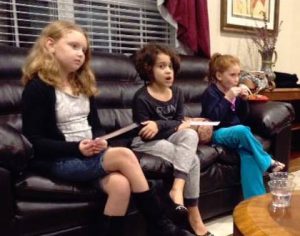 As we looked forward to each month’s meeting, the girls were paying so much attention to different aspects of the book as they read because they knew they’d get a chance to explore all of it at book club with friends. One really fun part was noticing foods they ate in the book and then each of us picking something applicable to bring to eat at book club! I think the most interesting thing we ate was the “cut-up” we made from Turtle in Paradise. In the book, all the kids bring something—anything!—to go into the “cut-up”: avocado, onion, papaya, potato, banana, pineapple, lime juice, and hot sauce. We duplicated it! (It was one of those things you’re not sure you like but you keep eating to figure it out.)
As we looked forward to each month’s meeting, the girls were paying so much attention to different aspects of the book as they read because they knew they’d get a chance to explore all of it at book club with friends. One really fun part was noticing foods they ate in the book and then each of us picking something applicable to bring to eat at book club! I think the most interesting thing we ate was the “cut-up” we made from Turtle in Paradise. In the book, all the kids bring something—anything!—to go into the “cut-up”: avocado, onion, papaya, potato, banana, pineapple, lime juice, and hot sauce. We duplicated it! (It was one of those things you’re not sure you like but you keep eating to figure it out.)